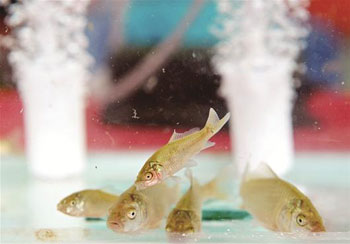When will the commercialization of genetically modified carp in China break?
Original title: when will the transgenic Yellow River carp "jump the dragon gate"?

Transgenic carp seedlings cultivated by Institute of Aquatic Sciences, Chinese Academy of Sciences (photo source: Yicai.com)
Recently, the United States Food and Drug Administration (FDA) officially approved the market of genetically modified salmon, making the United States the first country to "eat crabs" in the field of GM animal consumption.
However, what many people do not know is that the United States is actually a latecomer to the market of genetically modified fish.
In 1990, a report about the world's first genetically modified fish was published in the New York Times. The "owner" of the fish is Zhu Zuoyan, an academician of the Chinese Academy of Sciences and a researcher at the Institute of Aquatic Biology of the Chinese Academy of Sciences. At that time, the technology was three years ahead of its American counterparts.
Unfortunately, 25 years later, the United States has commercialized the world's first genetically modified fish, while Chinese scientists' pioneering technology in this field is still hovering around the city.
The helplessness of the frontrunner
In 1983, the team led by Zhu Zuoyan successfully introduced the recombinant human growth hormone gene into the fertilized eggs of crucian carp through "microinjection technique" and obtained the fast-growing transgenic fish.
"when we made the first genetically modified fish, many people abroad were very surprised." Zhu Zuoyan told China Science Daily that the idea of genetically modified fish was inspired by famous biologist Tong Di Zhou. "but with the level of technology at that time, it was impossible for us to get the genes of the fish, so we had to transfer the overall DNA in."
After the trial, Zhu Zuoyan's confidence increased. In 1991, he "transformed" the Yellow River carp. "We cloned the grass carp growth gene, replaced the actin gene promoter of the carp, and then transferred it to the fertilized eggs of the Yellow River carp, giving the Yellow River carp a protein that promotes the growth of grass carp."
The study shows that under the same culture conditions, the average growth rate of transgenic carp is 52.93% faster than that of ordinary Yellow River carp by 114.92%. After many generations of screening, the researchers obtained a stable strain of "transgenic whole fish growth gene Yellow River carp". This technology can shorten the breeding cycle by half, which not only reduces the breeding cost and risk, but also greatly reduces the labor intensity. "the annual output of carp in China is more than 5 million tons, which has great potential for application." Zhu Zuoyan said.
American businessmen with a keen sense of smell soon realized that this could be a rare business opportunity. In 2000, Elliot Entis, the first president of AquaBounty Technologies, an American company that cultivated genetically modified salmon, came to Wuhan to seek possible cooperation with Zhu Zuoyan.
"they were very interested in our research, but since carp didn't have a big market in the United States, it didn't work out. If you made salmon that year, you would probably be the first to go on the market. " Zhu Zuoyan said.
So why didn't the world's first genetically modified fish be marketed in China?
"it's hard to explain." Zhu Zuoyan said, "although I am in a leading position in research, I have no confidence and the government will not have the courage to be the first to enter the market, especially in the face of public opinion that GM has been misunderstood for a long time."
The scientific significance is far greater than the practical significance.
Although he failed to hit the line, Zhu Zuoyan was still pleased with the launch of genetically modified salmon in the United States.
"this is a good thing." In Zhu Zuoyan's view, the significance of the listing of genetically modified salmon lies not only in the event itself. "it opens the door for genetically modified animals to enter the market and plays a great role in promoting the consumption of genetically modified agricultural products, and the scientific significance is far greater than the practical significance."
In fact, in the process of listing genetically modified salmon, the United States can also be described as step by step. FDA did not complete its food safety assessment until 2010 and released an environmental impact assessment in 2012. "the reason why it took so long to finally go public is on the one hand to take into account the public reaction, but also the pressure from the traditional salmon industry." Luo Yunbo, dean of the School of Food Science and Nutrition Engineering at China Agricultural University, told China Science Daily that the final listing is the result of multiple factors.
"the government's decision is crucial, indicating that it can judge that this matter represents the future productivity and direction of development." Zhu Zuoyan stressed.
Not only that, scientists also have a clear understanding of their functions. "American scientists know very well which step to do and who should take the relay, unlike our scientists, who have to do everything from research to marketization." Zhu Zuoyan said.
Such strength comes from the strong R & D transformation mechanism of American society. "A new scientific discovery, without the need for scientists to communicate with society, companies with strong market ideas will automatically come to the door." Zhu Zuoyan was deeply moved by the persistence of American companies in dealing with the government. "AquaBounty Technologies continued to file even though it was dragged down by the approval process, and we had no experience and confidence at that time. We are responsible for this. "
More reflection is needed.
In terms of GM research, China may have lost more than just a fish.
"Mr. Zhu Zuoyan's genetically modified Yellow River carp is a case I have often mentioned." Luo Yunbo said that such a regret would put China in a passive position in its GM strategy. "in the future, our research in the fields of health, environment, pharmaceuticals and nutrition will be controlled by others, and it is not just a matter of genetically modified foods."
In Luo Yunbo's view, there may be some deviation in the public's understanding of GM. "what many people don't know is that our insulin is genetically modified, and so is the hepatitis B vaccine."
The attitude of the government also makes scholars feel helpless. "in major GM research projects, as long as it involves popular science, it is either cut by government departments or funding is reduced. It's hard for them to understand why popular science needs so much money. " Prior to this, Luo Yunbo applied for 5 million yuan to make some genetically modified documentaries with the agricultural studio, but after layers of examination and approval, only 1 million yuan was left. "in this way, what can be done is very limited." "the government's attitude towards innovation should not be the icing on the cake. It should provide timely assistance." Zhu Zuoyan said that the government's task is to identify and remove any obstacles that may arise in innovation-driven development, and to guide and support it when it is most needed. "in the national major genetically modified research project, genetically modified fish, which has advantages and application prospects, has not been included."
Zhu Zuoyan called on China to form a complete R & D transformation mechanism in the future. If the enterprise can not become the main body of innovation, no matter how many achievements scientists produce, it will not help. "our genetically modified Yellow River carp has long been ready, and now we only need the government's decision-making access." (our reporter Li Yu)
Related
- A course of planting techniques and methods on how to grow carrots
- How to plant the latest tulips?
- Is it better to pick tea in the morning or in the afternoon? When is the best time for tea to be picked? what is the third or fifth tea?
- Launch Yuanxiao Happy combination Haocha + Tea Yuan healthy Taste
- Penghu Tourism "Fireworks 20 Parade with You"
- 2022 West Lake Happiness holds "Digital Revitalization Voucher" and draws iphone13 and laptop.
- Banqiao Fuzhou social houses are designed to change start-up combined with police elimination to create a safe and livable environment
- The convenient measure of "mechanical weeding" in Xinbei has been abused and the Agriculture Bureau has imposed heavy penalties on the illegal land consolidation.
- Changgeng University Joins Hands with Four Memory Factories to Rescue Memory Talent Shortage
- The list of Taiwan's top 100 MVP managers is listed by the Director-General of the Farmers' Association of Sanxia District.



